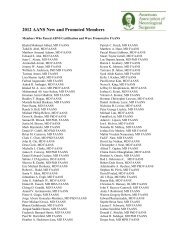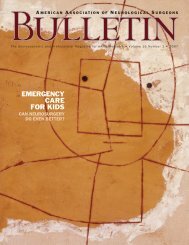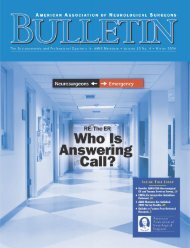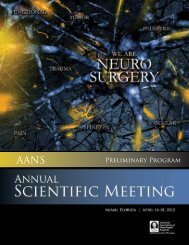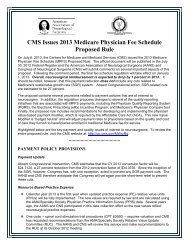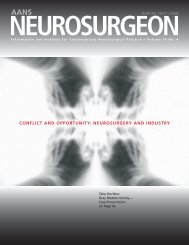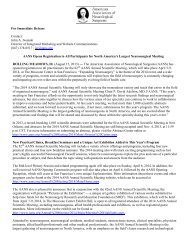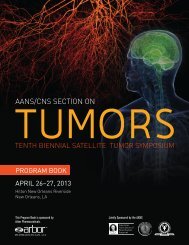view PDF - American Association of Neurological Surgeons
view PDF - American Association of Neurological Surgeons
view PDF - American Association of Neurological Surgeons
You also want an ePaper? Increase the reach of your titles
YUMPU automatically turns print PDFs into web optimized ePapers that Google loves.
P ATIENTS AFETY A RNOLD A. ZEAL, M D<br />
Error Results in Doctor’s Paradigm Shift<br />
Protocols, Team Approach and Site Marking Increase Patient Safety<br />
As a board-certified neurosurgeon in<br />
practice for nearly 30 years, I have<br />
served as chair <strong>of</strong> the neurosurgery<br />
section at a major medical center<br />
and as vice chair <strong>of</strong> the entire surgery<br />
department for a number <strong>of</strong> years. As vice<br />
chair <strong>of</strong> the surgery department, I was also<br />
chair <strong>of</strong> the department’s Quality Assurance<br />
Committee, and I additionally served<br />
as a sitting member <strong>of</strong> that committee for<br />
eight years.<br />
During my tenure in these positions, I<br />
was faced with several instances <strong>of</strong> medical<br />
errors involving colleagues, including<br />
wrong-site surgery. I listened to surgeons<br />
describe how their errors occurred and<br />
always found myself very unsympathetic. I<br />
could not imagine how conscientious surgeons<br />
could make such errors and could<br />
not, in my wildest dreams, imagine it happening<br />
to me. I am one <strong>of</strong> those compulsive<br />
surgeons who checks, double-checks, and<br />
even sometimes triple-checks things during<br />
surgery to the extent that my partner and<br />
operating room staff <strong>of</strong>ten tease me about<br />
being so obsessive-compulsive.<br />
Then it happened to me. I learned that<br />
we all make mistakes. It is easy. We are<br />
human. In fact, when I was forced to<br />
re<strong>view</strong> the literature to produce a lecture<br />
on this topic, I discovered that the numbers<br />
<strong>of</strong> medical errors and wrong-site<br />
surgeries and the injuries they cause are<br />
unbelievable.<br />
I became a convert, and in 2003 I was<br />
one <strong>of</strong> the surgeons and other health pr<strong>of</strong>essionals<br />
and organizations standing with<br />
the Joint Commission on Accreditation <strong>of</strong><br />
Healthcare Organizations strongly advocating<br />
and promoting the Universal Protocol<br />
for Preventing Wrong Site, Wrong Procedure,<br />
Wrong Person Surgery. The following<br />
account describes how I came to be there<br />
and what I learned along the way.<br />
Anatomy <strong>of</strong> a Medical Mistake<br />
In December 2000, a former partner <strong>of</strong><br />
mine referred his best friend to me for<br />
treatment <strong>of</strong> an L3–4 disc herniation. The<br />
patient, an internist, was well known to me.<br />
Examination revealed a mild right footdrop.<br />
A magnetic resonance image demonstrated<br />
a moderately large, very central<br />
herniated nucleus pulposus at L3–4, plus a<br />
very small extruded fragment on the right.<br />
The patient was scheduled for surgery a few<br />
days later, on a Monday.<br />
The weekend before the surgery was<br />
particularly memorable for me, with several<br />
exciting events transpiring. When I came<br />
to the OR, I enjoyed telling everyone the<br />
weekend’s exciting details during the case.<br />
In addition, to accommodate the patient, I<br />
had elected to perform the surgery in the<br />
hospital where he practices, an excellent<br />
institution where I rarely perform elective<br />
surgery, although I do assist my colleagues<br />
in covering this facility. At my usual hospital,<br />
the rooms are rectangular and the<br />
operating table is always set up parallel to<br />
the long axis <strong>of</strong> the room in a grid-like<br />
fashion, whereas in this hospital, the operating<br />
table is frequently on a diagonal.<br />
My usual routine<br />
is to scrub my hands,<br />
enter the room,<br />
check the X-rays and<br />
magnetic resonance<br />
images, then go to<br />
the side <strong>of</strong> the patient<br />
on which I intend to<br />
operate and finish<br />
prepping the skin<br />
with the antiseptic.<br />
At this hospital, the<br />
doctors are not permitted<br />
to prep the<br />
skin, so I had to<br />
enter, mark the site<br />
and help drape from the most accessible<br />
side <strong>of</strong> the patient. Aside from having a<br />
minimal acquaintance with the anesthesiologist,<br />
I knew no one else in the room, and<br />
as the case proceeded, I realized they also<br />
were inexperienced regarding my particular<br />
techniques.<br />
I started the case standing on the<br />
patient’s left side because, as I entered the<br />
room with the table somewhat askew, I<br />
stood there to help drape. I took an X-ray<br />
to confirm my level, L3–4, as I exposed the<br />
lamina. I then proceeded with the laminotomy.<br />
I was easily able to identify a large<br />
central disc herniation, but no free fragment.<br />
A second X-ray was taken to confirm<br />
the level, and then I extended the small<br />
laminotomy cranially and caudally looking<br />
for the free fragment. A third X-ray confirmed<br />
that I was at the L3–4 level as<br />
intended. Eventually I incised into the large<br />
herniated disc and performed a discectomy.<br />
The small extruded fragment was not<br />
located, but I had long since learned that<br />
sometimes findings are not exactly as<br />
expected. I did detect and remove a large<br />
herniation, decompressing the thecal sac<br />
and nerve roots.<br />
28 AANS Bulletin • www.AANS.org



